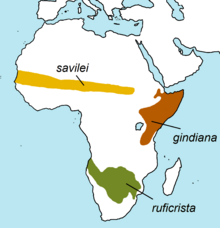Redhead bustard
| Redhead bustard | ||||||||||
|---|---|---|---|---|---|---|---|---|---|---|

Red-headed bustard in the Kruger National Park |
||||||||||
| Systematics | ||||||||||
|
||||||||||
| Scientific name | ||||||||||
| Lophotis ruficrista | ||||||||||
| ( Smith , 1836) |
The red-headed bustard ( Lophotis ruficrista ) is a species of bird in the bustard family . It occurs in southern Africa and is closely related to the Saviletrappe from the Sahel zone and the East African Oustalettrappe . The three forms are sometimes combined into a single species.
features
The red-headed bustard grows to around 50 cm long and weighs around 680 g. The top is adorned with eye-catching, cream-colored, V-shaped markings that create a piebald effect. The male's red neck, which gives it its name, is only visible when it is erect. The front of the neck is gray, the back is beige, the belly is black. The beak is grayish, the legs yellowish.
The red-headed bustard differs from the Oustalettrappe and the Saviletrappe in that it has a larger proportion of gray on the head and the paler upper side. The females are similar to the males, but the gray parts of the head and neck are replaced by brown parts. They can be distinguished from female Gackelbrappen by the V-shaped markings and the lack of black facial markings.
Occurrence

The distribution area of the red-headed bustard stretches across southern Africa in a strip. It extends from southern Angola and north-east Namibia in the west through Botswana, south-west Zambia and Zimbabwe east to Mozambique, and into northern South Africa and Swaziland.
habitat
Red-headed chestnuts inhabit thorny terrain, as well as other dry savannah landscapes and forms of vegetation close to the banks. In Botswana, the animals are most common in Acacia and Terminalia savannas. In more open areas they are represented by the white-winged bustard. In the south of the Kalahari, however, there is a population of the red-headed bustard that lives in treeless, grassy dunes. This population also differs from the rest of the species in its song.
Way of life
The redhead is a resident bird. Little is known about their eating habits. The animals feed primarily on insects such as beetles, grasshoppers, termites and ants, as well as other small arthropods . Berries, seeds and tree resins are also eaten. The breeding season lasts from October to April. In the Transvaal , the peak is in October and November. The nest is made on the ground and is often near a sapling or shrub. The clutch usually comprises 1–2 eggs.
Existence and endangerment
The redhead is still common in large parts of the distribution area, for example in the Transvaal and Botswana. In Zimbabwe, where the species is also still relatively abundant, heavy grazing in many areas may have caused some local declines in redhead populations.
literature
- Josep del Hoyo , Andrew Elliot, Jordi Sargatal : Handbook of the Birds of the World. Volume 3: Hoatzin to Auks. Lynx Edicions, Barcelona 1996, ISBN 8487334202 .